Is ballet dying or is it just an appropriate metaphor for death? Are we in love with the idea of ballet and all it stands for or are we repulsed by the obscure side that is in juxtaposition to its physical form.This grappling with the mythology of dance must grapple with connecting an allegedly ancient Greek mythology to the contemporary real world; and dance is a direct direct channel between that spiritual world of the gods, Apollo, his three muses, and their ancestors and the people who co-mingle with us. The past and the contemporary, the living and the deceased, the garden variety and the divine, all appear represented by the magic of dance….
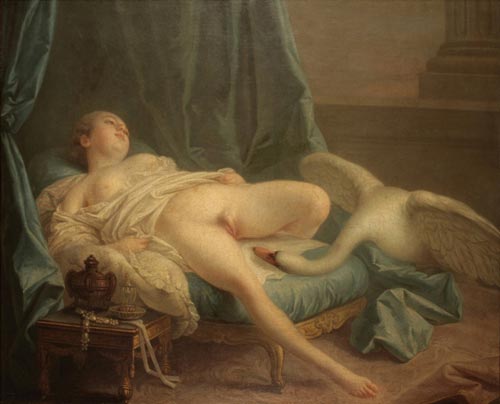
Leda and the Swan. Francois Boucher. 1740. Read More: http://www.studio-international.co.uk/studio-images/seduced/swan_b.asp
“Swan Lake remains a pervasive myth.
Myth is real. In valuing scientific studies as certain truths, stock market figures as measures of success, and other such (actually unstable) markers of trust, flights of fantasy often become relegated to “entertainment,” and myth equates with fantasy. But myths are pervasive, and come back at us in the form of social norms, philosophical discourses, architectures, popular candies, nervous disorders, hypotheses to be tested in scientific studies, and waves of fashion that make people money and fame and stock market success. This is not an argument against the science of science, or even the business of money. It is an argument against the assumed separation between myth and the world of impact. If myths help define us, they define art, inform ideas and perceptions, have an impact on our bodies and histories. Which is to say, dance has an impact on our bodies, our histories. Read More: http://www.dance-tech.net/profiles/blogs/myth-amp-the-movies-the-swan a
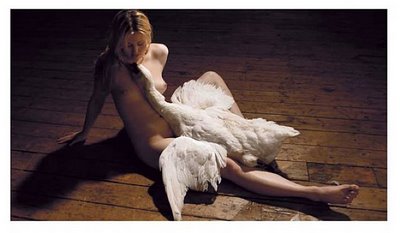
"...about the myth of leda and the swan as i prepare for my upcoming show at mew gallery this august. i was struck by this myth of how zeus took the form of a giant swan and imposed himself in this form on the young and beautiful leda. the idea of the veil between mortals and the gods being so flimsy was captivating to me, as well as the choice of bird zeus choose. the result of this rape was the birth of twins castor and pollux as well as helen of troy and clytemnestra, thought to have been hatched within two separate twin eggs from leda. such a bizarre and striking image to reset the imagination. this is a photo entitled 'that white rush' from photographer/film maker sam taylor-wood. the title comes from a line from the lovely yeats poem..." Read More: http://bloodmilkjewelry.blogspot.com/2009_06_01_archive.html
…Ballet first grew out of court entertainments in France and Italy, developing to embody aristocratic comportment and coming to full fruition during Louis XIV’s reign. By 1715, the year of his death, the dance had spread throughout Europe. Or is it just a case of ballet not being what it used to be? My point is that when one is dedicated to something, the more one loves it, the more one wishes to share it with others. I think that we are all agreed, that outside Russia, in the Western world generally, ballet is no longer of the remotest interest to the population. It has become a pastime for a narrow circle within the educated elite.( Kanter)
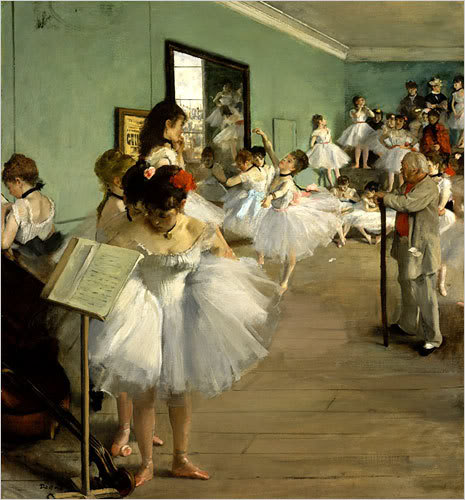
"According to the Opera's own statistics, out of a country of sixty million people, rather less than three thousand regularly attend performances of the ballet and opera combined. The French word for a theatrical performance is a "spectacle": a thing you look at, not something you do. Sets, costumes, lovely women... One cannot "tiptoe round" that ice-cold, police-agent character of French official culture: the only viable option is to change it in a fundamental way." Read More: http://www.ballet.co.uk/magazines/yr_01/dec01/kk_colour_bar.htm image: http://www.gallerydirect.com/nep_product.php?utm_campaign=134-2010Q1-W-GD%28shopzilla%29&utm_medium=product_feed&utm_source=shopzilla&image_code=V00717
“Until the 1960s, there were no ballet competitions of any significance. But, somehow, the Spessivtsevas and Fonteyns of this world, muddled through. There was no television, no Internet, indeed, no instantaneous forms of communication at all. And yet, Ulanova, Kronstam, Chauviré…emerged. My thesis is that the very existence of these international competitions, is a major factor in dumbing down the level of classical dancing today. I would include amongst these competitions, the notorious Concours de Promotion Interne of the Paris Opera”,… Read More: http://www.ballet.co.uk/magazines/yr_02/mar02/kk_competitions.htm
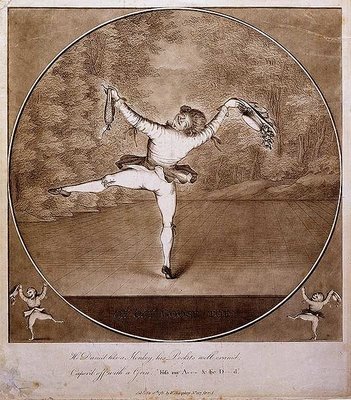
"Gaetano retired a national hero in England in 1782, but not before he fathered a son, Auguste, with his mistress Marie Allard. Auguste was considered by the nobility all over Europe to be the greatest dancer of his time. Sometimes referred to as Vestr’Allard, he made his debut in La Cinquantaine in 1772. He became the Premier Danseur in Paris in 1778 and retained that title for 35 years. Auguste danced in the first production of Noverre’s and Mozart’s Les Petits Reins. By all reports, he was short and knock-kneed, and yet quite conceited like his father. When he was 75 years old, he performed with his famous student Marie Taglioni. " Read More: http://artistsworkbench.blogspot.com/2009_06_01_archive.html
Black Swan is both aesthetically seductive, manipulative and also a bit repulsive and horrific. The film is really designed to entertain on a mass level on the one side, as well as using this dying art form as a metaphor for death, tragedy and a glorification of the body in almost Leni Riefenstahl fashion where the fall of the goddess, her age and alienation, becomes inevitable. She has to be euthanized. There is also the simplistic idea where white swans are precision and goodness and black is bad, occult and violent. Add to this the additional trope that sex is the primal driver of all meaningful art.
Using the theory of Otto Rank, these swans are all raised in order to be raped; to wait for their Don Juan – the Greek god Cronus- before his phallus is heaved into the ocean. So the film is also about unconscious anxiety that some dead ballet dancer, like a ghost might lift themselves up and begin rambling to haunt the living and wreak vengeance on other swans. Again, using Rank, the art form of dance is itself a struggle against the materialized feeling of guilt- in this
e the “primal crime” of being violated by the son who has killed the father.… Throughout, Homans stresses that ballet “is a deeply conservative and insular art that resists change,” linking it to beauty and nostalgia and noble ideals. But this truth is not the whole truth. As Homans herself documents, ballet was continually adapting, even as it retained certain core values. The Russian courts, for example, mimicked French high culture under Peter the Great, importing (and inevitably altering) ballet as a key element of a larger Westernization campaign that stretched from fashion to language. Roughly 200 years later, the Russian impresario Serge Diaghilev electrified Paris with his star-laden, modernist-thinking Ballets Russes, in part offering the French an exotic fantasy of Russia. Read More: http://www.slate.com/id/2274746/pagenum/2
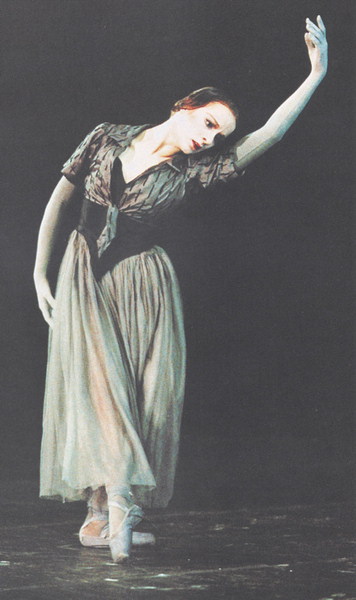
Elisabeth Maurin. "The lack of anything even remotely approaching the choreographic standard of Jules Perrot or Auguste Bournonville over the past century, has meant that interest in theatrical dancing now tends to boil down to hero worship of the individual artist. Seen from a dancer's standpoint, unless one is a complete narcissist – and there are of course, such people in the profession – this is a heavy burden to shoulder. One is expected to go out, and single-handedly make brain-pounding trivia, such as Kylian or Forsythe, or a third-rate rehashing of Petipa, look like art. That audiences continue to come to the ballet at all, under circumstances of near-zero choreographic excitement, is proof nonetheless of the incredible commitment of that handful of dancers who can make a silk purse out of a sow's ear." Read More: http://www.ballet.co.uk/magazines/yr_02/feb02/kk_maurin.htm image: http://www.ballerinagallery.com/maurin.htm
Much of Black Swan then is about escaping this dilemma, through the perfection of the art form of dance. But this is an impossible ideal. The nervous disorders and suicides, and cases of depression among dancers appears to be far beyond the norm; the collateral damage of the forging of the will toward the insurmountable. Perfection is not real, and to chase it means death and to invite the violence , the black obscurity, and the pathologies that accompany perfection: the jealousy, delusion, bulimia, physical deformation etc..
ADDENDUM:
Read More: http://auguste.vestris.free.fr/Vestris.html a
a

Harriet Hoctor and Fred Astaire. ---"Competitions force students to work hard at their technique" The sort of technique demanded from a competitor, is one that will distinguish him from everyone else, viz., more, faster, higher. True artistry is not sufficiently spectacular to qualify as "technique" in front of a baying crowd. ---Read More: http://www.ballet.co.uk/magazines/yr_02/mar02/kk_competitions.htm image: http://www.hoosickhistory.com/biographies/HarrietHoctor.htm
Chief among her omissions is the American choreographer William Forsythe, who is widely acknowledged to have changed the face of contemporary ballet at the end of the 20th century. By using (and often dismantling) the language and conventions of ballet itself, he pushed the form forward technically and intellectually, demonstrating how ballet could speak to a fractured world at a time when the great modern giants were going or gone. One can love or revile him for his dizzyingly layered worlds, where explosive, slippery movement is increasingly only one aspect of a larger theatrical exploration. To barely acknowledge his existence is mind-boggling. (Homans includes him in one footnoted aside.)…
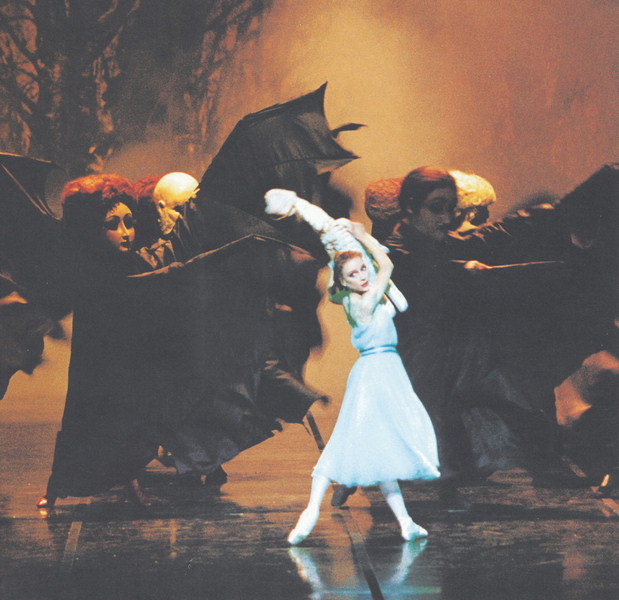
Elisabeth Maurin. "No-one has ever been infatuated with Mlle. Maurin, least of all herself. Indeed, when the tiny redhead in her size two slipper steps out on stage, towered over by the splendid corps de ballet, a slight sigh of disappointment travels round the house. Until she begins to dance. At which point, there is utter silence, even in the cavernous spaces of the Bastille Opera, a latter-day Coliseum where the Jolly Green Giant himself would have difficulty in projecting across the footlights. The first thing one notices, in all her roles, is a childlike freshness, devoid of all cynicism. This is no nymphet glued to night-time Reality TV. Few spectators still believe in the character of the Sylphide, Giselle, James or Albrecht, because the nineteen year-olds dancing the parts today, look as though they had just straggled in from a Techno-Rave event. They will believe in Mlle. Maurin. " Read More: http://www.ballet.co.uk/magazines/yr_02/feb02/kk_maurin.htm image: http://www.ballerinagallery.com/pic/maurin02.jpg
And what of the newest generation of choreographers: the Russian Alexei Ratmansky, who is pushing the muscular Soviet tradition in intriguing directions, mixing it with Western ideas in ways that would have been impossible to imagine during the Cold War? Or the Englishman Christopher Wheeldon, an heir to Frederick Ashton and Balanchine, who is searching for new ways of telling stories through abstraction? We don’t yet know if what these artists are doing will stand the test of time (that dubious phrase). But in their hands, ballet—now far from a matter of state, and thank goodness—remains a mutable, living language. Read More: http://www.slate.com/id/2274746/pagenum/2
Margaux Williamson: But in Black Swan, Darren Aronofsky’s intentions seem much more articulated and transparent. It seems as though he has set himself up in this underworld, roaming around in the clichés and sludge, because that is the place he loves the best. His pleasure and a very subtle humour accompany everything – though there are no jokes. It helps here that the characters are not victims of drugs, but of excellence. The goal for excellence frames the masochism involved, in this decent into the underworld, as a rare pleasure rather than a necessary cost of pleasure. Read More: http://backtotheworld.net/
One of the best things about the movie is the complete naivety that surrounds Nina as she bravely and blindly attempts to descend to the depths. Because of her inexperience in these depths, she gives everything she finds there the same value: sex is equal to murder is equal to confidence. This makes her quite a villain.
Throughout the movie, Nina longs to earn the ballet director’s nickname “little princess” that he bestows on only the rarest and finest of Swan Queens. It is really something to see how bloody things get before this small woman finally earns her nickname.Read More: http://backtotheworld.net/






 COMMENTS
COMMENTS